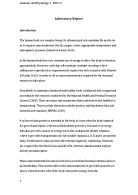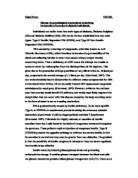Conduct the Queens Step test (provided) for all 4 students. Record the resting heart rates before commencing test and record recovery rates for five minutes after completion of test. Construct a suitable chart to record all information, including norms.
PDHPE Assessment Task By Alice Sherwood Part A a) Conduct the Queens Step test (provided) for all 4 students. Record the resting heart rates before commencing test and record recovery rates for five minutes after completion of test. Construct a suitable chart to record all information, including norms. Norms chart of step test- exercise pulse: Step test scores Exercise pulse Rating Men Women Boys Girls Very good Good OK Poor Very poor <110 00-124 25-140 41-155 >155 <116 16-130 31-146 47-160 >160 <120 20-130 31-150 51-160 >160 <124 24-134 35-154 55-164 >165 The following line graph shows the results of the pulse rates at resting, after test and every minute of recovery: b) Interpret each student's results and comment on her level of aerobic fitness. Decide which student you determine to be the "least fit" and justify your choice. - Step test: 4 students- Ella, Megan, Taufa, Rafaela Student 1- Ella Ella took part in the step test and had a resting heart rate of 90 beats per min. Immediately after 3 minutes of exercise, from which the body entered the aerobic energy system; her heart rate was 174 beats per min. On the chart of norms, this result is categorised in the very poor zone. After 5 minutes of recovering time, her heart rate was 102 beats per min. Comparing this result to her training program, it is clear that they are
Monitoring Food and Its Effects on the Body
Anatomy and Physiology 2 SBI172 Laboratory Report Introduction The human body is a complex being. Its ultimate goal is to maintain life and to do so it requires macronutrients (food), oxygen, water, appropriate temperature and atmospheric pressure (Marieb & Hoehn 2010). In the human body there are constant use of energy to allow the body to function appropriately. Moreover each day cells undergo constant recycling, where millions are reproduced or regenerated to replace the old or injured cells (Marieb & Hoehn 2010). In order to do so macronutrients are required for the chemical reaction to take place. Henceforth, to maintain a balanced and healthy body, a balanced diet is important according to the research conducted by the National Health and Medical Research Council (2005). There are many macronutrients that contribute to the health of a human being. These include elements includes protein, carbohydrates, fats, and minerals and vitamins (NHMRC 2005). It is known that protein is essential to the body as it provides the body material for growth and repair, whereas carbohydrates provide a rich source of energy. Fats also provide a source of energy but it also contains fat-soluble vitamins, where it provides transportation for fat-soluble vitamins A, D, E and K around the body. Furthermore it also protects the internal organs by cushioning. Minerals
Discuss the physiological mechanisms underlyingthe benefits of exercise in diabetic individuals.
Nigel Penny. 9707584. Discuss the physiological mechanisms underlying the benefits of exercise in diabetic individuals. Individuals can suffer from two main types of diabetes, Diabetes Insipidus (DI) and Diabetes Mellitus (DM). DM can be further subdivided into two main types: Type I/ Insulin Dependent DM (IDDM), and Type II/ Non-Insulin Dependent DM (NIDDM). DI is caused by a shortage of vasopressin, otherwise known as Anti Diuretic Hormone (ADH), which functions to increase the permeability of the distal and collecting tubules to water and reduce urinary output thereby conserving water. Thus a deficiency of ADH means the kidneys are unable to conserve water by reabsorption from the distal portions of the nephron. This gives rise to the production of large quantities of very dilute urine i.e. 20 liters per day, compared to the normal average of 1.5 liters per day (Sherwood. 1997). This can understandably lead to dehydration in sufferers unless compensated for with an increased water intake. DI can be easily treated with replacement vasopressin administered by nasal spray (Sherwood. 1997). However, evidence has not been seen that exercise would benefit DI sufferers, but would most likely augment the dehydration that can occur with this disease caused by the body excreting water in the form of sweat to act as a cooling mechanism. DM is predominantly caused by
Case study on Andrew Flintoff. Background information on Ankle Sprain which Andrew Flintoff is suffering from Ankle sprain
Case study on Andrew Flintoff Background information on Andrew Flintoff Full name: Andrew Flintoff Born: December 6, 1977, Preston, Lancashire Age: 29 years Sex: Male Major teams: England, ICC World XI, Lancashire Nickname: Freddie Batting style: Right-hand bat Bowling style: Right-arm fast Height: 6 ft 4 in Education: Ribbleton Hall High school Andrew Flintoff, MBE, was born 6 December 1977, Preston, Lancashire. He is a cricketer who plays for Lancashire and England. A tall (6' 4") fast bowler, aggressive batsman and fine fielder, he is seen as one of the best players in the modern game, and one of the few genuine all-rounders in the international game at the present time. His nickname "Freddie" or "Fred" comes from the similarity between his surname and that of Fred Flintstone. Since making his Debut in 1998, Flintoff has been an integral player, and has both captained and vice-captained the team. He has been plagued with injuries due to his bowling action, and in late 2007 a fourth ankle operation took him out of cricket until summer 2008. To date, injuries have cost him more than 20 Test appearances, a tally that is about to grow substantially. Flintoff's history of previous injuries * 1999 - Returns early from South Africa with broken foot.
Personal Exercise Programme
Age: 17 Height Weight Body Composition: Ectomorph. I am training to improve my overall fitness levels I am doing this so that I am able to me an improved athlete who will have very good endurance levels and therefore will be able to improve in my sport which is swimming. Target Zone: 60-80% Tests done for fitness so far: • The Harvard Step Test => Good • Bleep Test => Level 11.6 • 12 Minute Run =. 2700m • Muscle Endurance => Sitting Tucks => 30 Squat Thrust => 25 • Muscle Speed => Distance - 100m, Time - 13 seconds SESSION 1 - Monday - Cardiovascular equipment SESSION 2 - Wednesday - Cardiovascular equipment SESSION 3 - Friday - Body weight exercises WEEK 1 - 60% Rowing machine - 20 mins Bicycle machine - 20 mins Running machine - 20mins Rowing machine - 20 mins 20 press ups 5 Triceps dips 25 Sit ups 2 shuttles WEEK 2 - 60% Rowing machine -20mins Bicycle machine - 20mins Running machine - 20mins Rowing machine - 20 mins 4 times for 30 seconds -Crunches/abdominal curls 20 Toe raises 25 Tuck jumps 0 Pull ups WEEK 3 - 60% Rowing machine -22mins Bicycle machine -22mins Running machine - 22mins Rowing machine - 22 mins 5 Standing calf raises 7 Triceps dips 2 shuttles WEEK 4 - 60% Rowing machine -23mins Bicycle machine -23mins Running machine - 23mins Rowing machine - 23
Mechanics of Breathing and responses to exercise
Practical Three Mechanics of Breathing and responses to exercise Authors: Leah Frisby, Rebecca Murray, Shuchtra Ghash, Holly Franklin, Emily Gibbs, Rhian Jones, Jake Hatt, Thushe Joseph, Charlotte Hall, Emma Kirk Aims * To investigate how holding breathe for 30 seconds affects the tidal volume, respiratory rate and respiratory minute volume. * To find out how moderate exercise for 3 minutes affects the tidal volume, respiratory rate and respiratory minute volume. Introduction The respiratory system can be divided into to sections: the upper and lower respiratory system. The upper respiratory system consists of the nasal and oral cavities and the pharynx. The upper respiratory system warms and moistens the air before it reaches the lungs. The lower respiratory system consists of the trachea, the lungs and the diaphragm. The trachea, bronchi and bronchioles are the conducting zone and do not have a gas exchange role. The alveoli are the respiratory zone and gas exchange solely occurs here. The lungs are divided into lobes; the right lung divided into three lobes (superior, middle and inferior) whilst the left lung is only divided into two lobes (superior and inferior). The primary functions of the respiratory system are: * Exchange of oxygen from the atmosphere to the blood and of carbon dioxide from the blood to the atmosphere. * Providing protection from
Investigating the speed of a spherical object on a slope.
Year 10 GCSE Practical Assessment Physics Plan Investigating the speed of a spherical object on a slope Variables The following is a list of variables that I could change in my experiment. I may vary: * Material of slope (e.g. the ramp could be wood, metal or plastic) * Friction of slope (e.g. the ramp could have water on it or ridges) * Colour of slope (e.g. the ramp could be blue, red or green) * Size of slope (e.g. the ramp may have a small width across or length from top to bottom) * Temperature of slope (e.g. the ramp could be at room temperature or at lower temperature) * Height of slope (e.g. the ramp could be at 70cm from a surface or 20cm) * Angle of slope (e.g. the ramp could be at 90 degrees or 40 degrees from a surface) * Length of measurement (e.g. the spherical objects speed could be measured over 1m or 0.5m) * Material of spherical object (e.g. the object could be marble, rubber, plastic, metal, leather, glass or wood) * Type of spherical object (e.g. the object could be a tennis ball, marble, ball bearing, squash ball, rubber ball, hollow plastic ball or golf ball) * Friction of spherical object (e.g. the object could have ridges on it like a golf ball) * Colour of spherical object (e.g. the object could be blue, green, red or white) * Size of spherical object (e.g. the object may have a small diameter or circumference) * Temperature of
Negative effects of exercise Exercise is also known for its vast results with benefiting the aging process and functional capacity
Unit 15: exercise, health and lifestyle Negative effects of exercise Exercise is also known for its vast results with benefiting the aging process and functional capacity. It can increase muscular strength and stamina, increases/maintains bone mineral density preventing osteoporosis, maintains metabolic resting rate to prevent weight gain, improves joint integrity improves balance ad coordination and is even know to reduce the risk of developing colon or breast cancer. For such effects more lifting and movement orientated exercises are needed such as dancing, body building, swimming, etc. Again there are the risks to go with the exercises which could be more destructive with older members of the population. Contusions can occur which are bruises into the muscle tissue, more likely due to the frailness of the tissue, also making strains more likely. Fatigue is possible if the right energy food isn't eaten or if the use of exercise is too intense. Again, due to the age, arthritis and lower back pains would be more likely to be present and therefore call for a great deal more care when exercising. Besides the obvious physical benefits of exercise, it is also known to have various positive effects on the mental health of those who take up some form of exercise. It is praised for reducing mental states such as anxiety, stress, depression, restlessness. It also improves
Fatigue - affects on the body
Task 4 Fatigue The body uses food as energy as we have discussed in task 3 but when the body is low on what it needs it becomes fatigued. Often the thing the body is low on is oxygen, this is a major factor in fatigue. (Wilmore and Costill, 1988) described Fatigue as a general sensation of tiredness as well as a decrease in muscular performance. Muscular fatigue occurs in athletes after a tough training session. This description is very general and does not explain what causes fatigue. (Answers.com, 2005) believe fatigue is the decreased capacity or complete inability of an organism to function normally because off excessive stimulation. This description is better then the first as it states that excessive stimulation, even lack of sleep, will cause the body to fatigue. It is the body's way of saying it needs rest. (Gandevia et al., 1995; Hagberg, 1981; Hawley et al., 1997) describes fatigue as the inability to continue functioning at the level of one's normal abilities. This is also very general but it is clear in what it describes. performance may decrease for a number of reasons:(can performance improve) * accumulation of waste products lactic acid * depletion of energy stores glycogen * changes in physio chemical state of the muscle electrolytes * disturbances in the processes of muscular co-ordinbation-CNS Neuromuscular fatigue - neural fatigue and muscular
How muscles and joints are used by different sportspeople.
Assignment one Here are the profiles of my four clients: Name: David Beckham Age: 33 Sport: Football Name: Amir Khan Age: 21 Sport: Boxing Name: Paula Radcliff Age: 34 Sport: Long Distance Runner Name~Tim Henman Age: 33 Sport: Tennis Player The Skeleton Bones The Skeleton Functions Amir Khan's skeleton protects him from getting badly hurt. His rib cage protects him and the vital organs including the heart in that area. Without the protection of the rib cage Amir Khan would get injured. The skeleton supports David Beckham by holding him upright. Without a skeleton our body would collapse into a heap on the ground. Without the support of the skeleton David Beckham would not be able kick the ball. Paula Radcliffe is able to move because of the co-operation between the muscles and bones. The muscles are attached to the bones which create a joint and lever system which allows the bones to move freely. Tim Henman needs his skeleton to give his shape. The skeleton gives him the framework to give the rest of his body recognizable shape. We all have the same skeleton structure. Animals have a different structure to us humans. Without your skeleton you would fall to the ground. Blood Cell Production Red and White Blood Cells are produced in the bone marrow of the ribs, humerus, femur and vertebra. Red Blood Cells transport oxygen around the body. The











